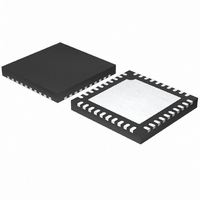MAX8760ETL+T Maxim Integrated Products, MAX8760ETL+T Datasheet - Page 16

MAX8760ETL+T
Manufacturer Part Number
MAX8760ETL+T
Description
IC CNTRLR QUICK PWM 40-TQFN
Manufacturer
Maxim Integrated Products
Datasheet
1.MAX8760ETL.pdf
(39 pages)
Specifications of MAX8760ETL+T
Applications
Controller, 6-bit VID AMD Mobile Turion™
Voltage - Input
4 ~ 28 V
Number Of Outputs
2
Voltage - Output
0.38 ~ 1.55 V
Operating Temperature
0°C ~ 85°C
Mounting Type
Surface Mount
Package / Case
40-TQFN Exposed Pad
Output Voltage
0.375 V to 1.55 V
Output Current
4000 mA
Mounting Style
SMD/SMT
Switching Frequency
550 KHz
Maximum Operating Temperature
+ 100 C
Minimum Operating Temperature
- 40 C
Synchronous Pin
No
Topology
Buck
Lead Free Status / RoHS Status
Lead free / RoHS Compliant
Dual-Phase, Quick-PWM Controller for AMD
Mobile Turion 64 CPU Core Power Supplies
The two phases in the MAX8760 operate 180° out-of-
phase (SKIP = REF or high) to minimize input and output
filtering requirements, reduce electromagnetic interfer-
ence (EMI), and improve efficiency. This effectively low-
ers component count—reducing cost, board space, and
component power requirements—making the MAX8760
ideal for high-power, cost-sensitive applications.
Typically, switching regulators provide transfer power
using only one phase instead of dividing the power
among several phases. In these applications, the input
capacitors must support high-instantaneous current
requirements. The high-RMS ripple current can lower
efficiency due to I
capacitor’s effective series resistance (ESR). Therefore,
the system typically requires several low-ESR input
capacitors in parallel to minimize input voltage ripple, to
reduce ESR-related power losses, and to meet the nec-
essary RMS ripple current rating.
With the MAX8760, the controller shares the current
between two phases that operate 180° out-of-phase, so
the high-side MOSFETs never turn on simultaneously
during normal operation. The instantaneous input cur-
rent of either phase is effectively cut in half, resulting in
reduced input voltage ripple, ESR power loss, and RMS
ripple current (see the Input Capacitor Selection sec-
tion). As a result, the same performance can be
achieved with fewer or less-expensive input capacitors.
Table 1 lists component selection for standard multi-
phase selections and Table 2 is a list of component
suppliers.
16
PIN
32
33
34
35
36
37
38
39
40
______________________________________________________________________________________
Dual 180° Out-of-Phase Operation
NAME
BSTS
CMN
DHS
CMP
CSN
CSP
DLS
LXS
V+
2
R power loss associated with the input
Detailed Description
S econd ar y Low - S i d e G ate- D r i ver O utp ut. D LS sw i ng s fr om P GN D to V
M AX 8760 p ow er s d ow n.
Secondary High-Side Gate-Driver Output. Swings LXS to BSTS.
Secondary Inductor Connection. LXS is the internal lower supply rail for the DHS high-side gate driver.
Secondary Boost Flying Capacitor Connection. An optional resistor in series with BSTS allows the DHS
pullup current to be adjusted.
Battery Voltage-Sense Connection. Used only for PWM one-shot timing. DH_ on-time is inversely
proportional to input voltage over a 4V to 28V range.
Main Inductor Positive Current-Sense Input
Main Inductor Negative Current-Sense Input
Secondary Inductor Positive Current-Sense Input
Secondary Inductor Negative Current-Sense Input
When a transient occurs, the response time of the con-
troller depends on how quickly it can slew the inductor
current. Multiphase controllers that remain 180 degrees
out-of-phase when a transient occurs actually respond
slower than an equivalent single-phase controller. To
provide fast transient response, the MAX8760 supports
a phase-overlap mode, which allows the dual regula-
tors to operate in-phase when heavy-load transients are
detected, reducing the response time. After either high-
side MOSFET turns off, if the output voltage does not
exceed the regulation voltage when the minimum off-
time expires, the controller simultaneously turns on both
high-side MOSFETs during the next on-time cycle. This
maximizes the total inductor current slew rate. The
phases remain overlapped until the output voltage
exceeds the regulation voltage after the minimum off-
time expires.
After the phase-overlap mode ends, the controller auto-
matically begins with the opposite phase. For example,
if the secondary phase provided the last on-time pulse
before overlap operation began, the controller starts
switching with the main phase when overlap operation
ends.
The MAX8760 is enabled when SHDN is driven high
(Figure 2). The reference powers up first. Once the ref-
erence exceeds its UVLO threshold, the PWM controller
evaluates the DAC target and starts switching.
FUNCTION
Pin Description (continued)
Transient Overlap Operation
D D
. D LS i s for ced hi g h after the
Power-Up Sequence











